Study on the Fracture Evolution Characteristics of Overlying Strata in a Fully Mechanized Mining Face with a Large Mining Height Based on a Three-Dimensional Large-Scale Physical Simulation Experimental System
Abstract
:1. Introduction
2. Experimental Design
2.1. Experimental Prototype
2.2. Three-Dimensional Similar Physical Simulation Scheme
2.2.1. Similarity Constant of Three-Dimensional Model
2.2.2. Experimental Model Similar Material Ratio
2.2.3. Construction Process of the Three-Dimensional Experimental Model
2.2.4. Scheme of Sensor Arrangement
3. Results and Discussion
3.1. Three-Zone Morphology Distribution of Overburden Fissure
3.1.1. Three-Zone Shape Distribution of Overburden Fissure
3.1.2. Variations in Microseismic Events in Coal Seam Mining
3.2. Characteristic Parameters of the Overburden Fissure
3.2.1. Sinking Amount of Overlying Strata
3.2.2. Overburden Fissure Density Distribution
3.3. Stress Distribution of Mining Overburden Fissure
3.3.1. Vertical Stress Distribution along the Strike of the Coal Seam
3.3.2. Tendency Direction Stress Distribution
3.4. Morphological Model of the Gas Transport and Storage Channel
4. Conclusions
- (1)
- After model cutting about 65 m from the bottom of the coal seam, there is an off-layer, which is the top of the overburden rock fissure zone and the bottom of the bending and sinking zone. At 25 m from the bottom of the coal seam, the rock layer is more fragmented as the collapse zone, which is 4.8 times the mining height. At 25–65 m from the bottom of the coal seam, there is a fissure zone, which is 12.5 times the mining height, and the range of off-layer fissure is abundant at the top of the fissure zone.
- (2)
- When the coal face advances to 45 m, a large number of microseismic events occur, the concentration of microseismic events is more significant, and the distribution range of microseismic events in the direction of the coal seam strike and height is expanded. For every 20 m of face advancement, there is a large-scale concentration of microseismic events. When the face advances to 200 m, the concentration of microseismic events is about 65 m in height, and the maximum height distribution is about 113 m.
- (3)
- The overburden subsidence expands progressively from the top to the bottom of the rock layers. The subsidence slope area widens, while the central compaction zone remains relatively flat, forming an irregular elliptical shape. There is an uplift phenomenon at the periphery of the subsidence area. At 39 m from the coal seam base, the maximum subsidence measured is 4.0 m, with the subsidence decreasing higher up along the rock strata. The fissure density forms a double-hump pattern, with the highest density (up to 5 fissures per meter) occurring on both sides of the subsidence zone. In contrast, the compaction area has a lower fissure density, ranging from 1 to 2 fissures per meter.
- (4)
- Coal seam mining causes the redistribution of stress in the rock layer around the mining space. In front of the work face (0~5 m), a stress reduction zone is formed. Moreover, 20 m in front of the work face is the range of the dynamic impact area, 20~70 m in front of the work face is the range of the mining impact area, and 70 m in front of the work is the area outside the zone that is unaffected by mining. The coal rock porosity in the high-stress state has a lower sensitivity to stress changes. In high-stress zones, the coal–rock porosity exhibits lower sensitivity to stress changes, with minimal variations in fissure permeability.
Author Contributions
Funding
Data Availability Statement
Conflicts of Interest
References
- Lu, Y.Y.; Zhang, H.D.; Zhou, Z.; Ge, Z.L.; Chen, C.J.; Hou, Y.D.; Ye, M.L. Current Status and Effective Suggestions for Efficient Exploitation of Coalbed Methane in China: A Review. Energy Fuels 2021, 35, 9102–9123. [Google Scholar] [CrossRef]
- Yuan, L.; Zhang, P. Development status and prospect of geological guarantee technology for precise coal mining. Meitan Xuebao/J. China Coal Soc. 2019, 44, 2277–2284. [Google Scholar] [CrossRef]
- Li, S.; Zhang, J.; Lin, H.; Ding, Y.; Bai, Y.; Zhou, Y.; Zhu, B.; Dai, Z. Thoughts on the development path of coal and gas co-mining technology in dual carbon strategy. Meitan Kexue Jishu/Coal Sci. Technol. 2024, 52, 138–153. [Google Scholar] [CrossRef]
- Noack, K. Control of gas emissions in underground coal mines. Int. J. Coal Geol. 1998, 35, 57–82. [Google Scholar] [CrossRef]
- Lunarzewski, L.W. Gas emission prediction and recovery in underground coal mines. Int. J. Coal Geol. 1998, 35, 117–145. [Google Scholar] [CrossRef]
- Wang, S.; Liu, K.; Wang, S.; Liang, Y.; Tian, F. Three-dimensional stochastic distribution characteristics of void fraction in longwall mining-disturbed overburden. Bull. Eng. Geol. Environ. 2022, 81, 414. [Google Scholar] [CrossRef]
- Xia, B.; Luo, Y.; Pan, C.; Gong, T.; Hu, H.; Ji, K. Coalbed methane flow characteristics based on fractal geometry and stochastic rough fracture network. Energy Sources Part A Recover. Util. Environ. Eff. 2021, 1–19. [Google Scholar] [CrossRef]
- Biały, W.; Prostański, D.; Bołoz, Ł. Selection of longwall shearers based on the results of research on the mechanical properties of coal. Sci. Rep. 2024, 14, 18606. [Google Scholar] [CrossRef]
- Szlązak, N.; Borowski, M.; Obracaj, D.; Swolkień, J.; Korzec, M. Comparison of methane drainage methods used in polish coal mines. Arch. Min. Sci. 2014, 59, 655–675. [Google Scholar] [CrossRef]
- Feng, G.; Wang, S.; Guo, Y.; Zhang, Y.; Bai, J.; Niu, L.; Du, Y. Optimum position of roadway in the middle residual coal seam between the upper and lower longwall gobs. Energy Sources Part A Recover. Util. Environ. Eff. 2021, 1–17. [Google Scholar] [CrossRef]
- Jia, H.; Wang, K.; Xu, C.; Fu, Q. Permeability distribution characteristics of underlying coal seam disturbed by mining activity. Energy Sources Part A Recover. Util. Environ. Eff. 2022, 44, 5032–5047. [Google Scholar] [CrossRef]
- Zhuo, R.; Zhao, P.; Li, S.; Liu, H.; Lu, W.; Lin, H.; Jin, S.; Jin, Q.; Lei, W.; Wu, J. Experimental study on the determination method of pressure relief gas transportation and storage channel under multiple factors. Environ. Earth Sci. 2024, 83, 386. [Google Scholar] [CrossRef]
- Li, X.; Yin, G. Gas migration model based on overburden strata fracture evolution law in three dimensional mine-induced stress conditions. IOP Conf. Ser. Earth Environ. Sci. 2017, 61, 012005. [Google Scholar] [CrossRef]
- Krishnamurthy, N.S.; Rao, V.A.; Kumar, D.; Singh, K.K.K.; Ahmed, S. Electrical Resistivity Imaging technique to delineate coal seam barrier thickness and demarcate water filled voids. J. Geol. Soc. India 2009, 73, 639–650. [Google Scholar] [CrossRef]
- Karacan, C.Ö.; Esterhuizen, G.S.; Schatzel, S.J.; Diamond, W.P. Reservoir simulation-based modeling for characterizing longwall methane emissions and gob gas venthole production. Int. J. Coal Geol. 2007, 71, 225–245. [Google Scholar] [CrossRef]
- Khodot, V.V. Role of methane in the stress state of a coal seam. Sov. Min. Sci. 1980, 16, 460–466. [Google Scholar] [CrossRef]
- Majdi, A.; Hassani, F.P.; Nasiri, M.Y. Prediction of the height of destressed zone above the mined panel roof in longwall coal mining. Int. J. Coal Geol. 2012, 98, 62–72. [Google Scholar] [CrossRef]
- Sobczyk, J. A comparison of the influence of adsorbed gases on gas stresses leading to coal and gas outburst. Fuel 2014, 115, 288–294. [Google Scholar] [CrossRef]
- Karacan, C.Ö.; Ruiz, F.A.; Cotè, M.; Phipps, S. Coal mine methane: A review of capture and utilization practices with benefits to mining safety and to greenhouse gas reduction. Int. J. Coal Geol. 2011, 86, 121–156. [Google Scholar] [CrossRef]
- Cheng, Y.; Pan, Z. Reservoir properties of Chinese tectonic coal: A review. Fuel 2020, 260, 116350. [Google Scholar] [CrossRef]
- Zhou, S. Mechanism of gas flow in coal seams. Mei T’an Hsueh Pao (J. China Coal Soc.) 1990, 15, 15–24. [Google Scholar]
- Somerton, W.H.; Söylemezoglu, I.M.; Dudley, R.C. Effect of stress on permeability of coal. Int. J. Rock Mech. Min. Sci. 1975, 12, 129–145. [Google Scholar] [CrossRef]
- Changwu, L.; Jian, Y. Research on main design parameters of three- dimensional mining physical simulation test equipment. Rock Soil Mech. 2003, 24, 325–328. [Google Scholar] [CrossRef]
- Yin, G.; Li, X.; Lu, J.; Li, M. Disaster-causing mechanism of compound dynamic disaster in deep mining under static and dynamic load conditions. Meitan Xuebao/J. China Coal Soc. 2017, 42, 2316–2326. [Google Scholar] [CrossRef]
- Yin, G.Z.; Li, X.; Han, P.B.; Li, M.H.; Li, W.P.; Deng, B.Z. Experimental study on overburden strata fracture evolution law in three dimensional mine-induced stress conditions. Meitan Xuebao/J. China Coal Soc. 2016, 41, 406–413. [Google Scholar] [CrossRef]
- Vu, T.T. Solutions to prevent face spall and roof falling in fully mechanized longwall at underground mines, Vietnam. Min. Miner. Depos. 2022, 16, 127–134. [Google Scholar] [CrossRef]
- Vu, T.T.; Pham, H.D. Influence of Underground Mining Activities on the Topographic Surface, Case Study of Nui Beo Coal Mine (Vietnam). Nauk. Visn. Nat. Hirn. Univ. 2023, 33–39. [Google Scholar] [CrossRef]
- Jiang, Y.; Liu, W.; Zhao, Y. Design and development of a new type of triaxial system for roadway model test. Yanshilixue Yu Gongcheng Xuebao/Chin. J. Rock Mech. Eng. 2004, 23, 3727–3731. [Google Scholar]
- Kang, J.; Wang, J. Analysis of dynamic subsidence of mining overburden strata. J. Taiyuan Univ. Technol. 2000, 31, 364–366. [Google Scholar]
- Shi, P.W.; Zhang, Y.Z. Structural analysis of arch of spanning strata of top coal caving in steep seam. Yanshilixue Yu Gongcheng Xuebao/Chin. J. Rock Mech. Eng. 2006, 25, 79–82. [Google Scholar]
- Lai, X.P.; Wu, Y.P.; Cao, J.T.; Fan, Y.N.; Zhang, Y.L.; Cui, F. Experiment on rock-mass deformation of large scale 3D-simulation in complex environment. Meitan Xuebao/J. China Coal Soc. 2010, 35, 31–36. [Google Scholar]
- Yang, K.; Liu, W.J.; Jiao, B.; Zhang, Q.H.; Liu, S.; Zhang, Z.N. Three-dimensional physical simulation of overburden migration in deep thick hard roof fully-mechanized caving mining. Yantu Gongcheng Xuebao/Chin. J. Geotech. Eng. 2021, 43, 85–93. [Google Scholar] [CrossRef]
- Ye, Q.; Wang, G.; Jia, Z.; Zheng, C.; Wang, W. Similarity simulation of mining-crack-evolution characteristics of overburden strata in deep coal mining with large dip. J. Pet. Sci. Eng. 2018, 165, 477–487. [Google Scholar] [CrossRef]
- Li, X.; He, W.; Xu, Z. Study on Law of Overlying Strata Breakage and Migration in Downward Mining of Extremely Close Coal Seams by Physical Similarity Simulation. Adv. Civ. Eng. 2020, 2020, 2898971. [Google Scholar] [CrossRef]
- Wen, Z.; Xing, E.; Shi, S.; Jiang, Y. Overlying strata structural modeling and support applicability analysis for large mining-height stopes. J. Loss Prev. Process Ind. 2019, 57, 94–100. [Google Scholar] [CrossRef]
- Li, S.; Wei, Z.; Lin, H.; Zhao, P.; Xiao, P.; Hao, Y. Research and development of 3D large-scale physical simulation experimental system for coal and gas co-extraction and its application. Meitan Xuebao/J. China Coal Soc. 2019, 44, 236–245. [Google Scholar] [CrossRef]
- Wei, Z.; Li, S.; Lin, H. Three-dimensional experimental study on evolution characteristics of overburden fractures in fully mechanized mining with large mining height. Xi’an Univ. Sci. Technol. 2020, 40, 589–598. [Google Scholar]
- Li, S.; Yang, E.; Lin, H.; Zhao, P. Construction and practice of precise gas drainage system for pressure relief gas in deep mining. Meitan Kexue Jishu/Coal Sci. Technol. 2021, 49, 1–10. [Google Scholar] [CrossRef]
- Lin, H.; Yang, E.; Xia, B.; Li, S.; Zhao, P.; Kong, X.; Qin, L. Directional drilling replacing tailgate gas drainage technology in gassy fully-mechanized coal mining face. Meitan Kexue Jishu/Coal Sci. Technol. 2020, 48, 136–143. [Google Scholar] [CrossRef]
- Li, S.; Ding, Y.; An, Z.; Li, H.; Wei, X. Experimental research on the shape and dynamic evolution of repeated mining-induced fractures in short-distance coal seams. Caikuang Yu Anquan Gongcheng Xuebao/J. Min. Saf. Eng. 2016, 33, 904–910. [Google Scholar] [CrossRef]
- Lin, H.F.; Li, S.G.; Cheng, L.H.; Wang, H.S. Experimental analysis of dynamic evolution model of mining-induced fissure zone in overlying strata. Caikuang Yu Anquan Gongcheng Xuebao/J. Min. Saf. Eng. 2011, 28, 298–303. [Google Scholar]
- Ding, Y.; Zhu, B.; Li, S.; Lin, H.; Wei, Z.; Li, L.; Long, H.; Yi, Y. Accurate identification and efficient drainage of relieved methane in goaf of high outburst mine. Meitan Xuebao/J. China Coal Soc. 2021, 46, 3565–3577. [Google Scholar] [CrossRef]

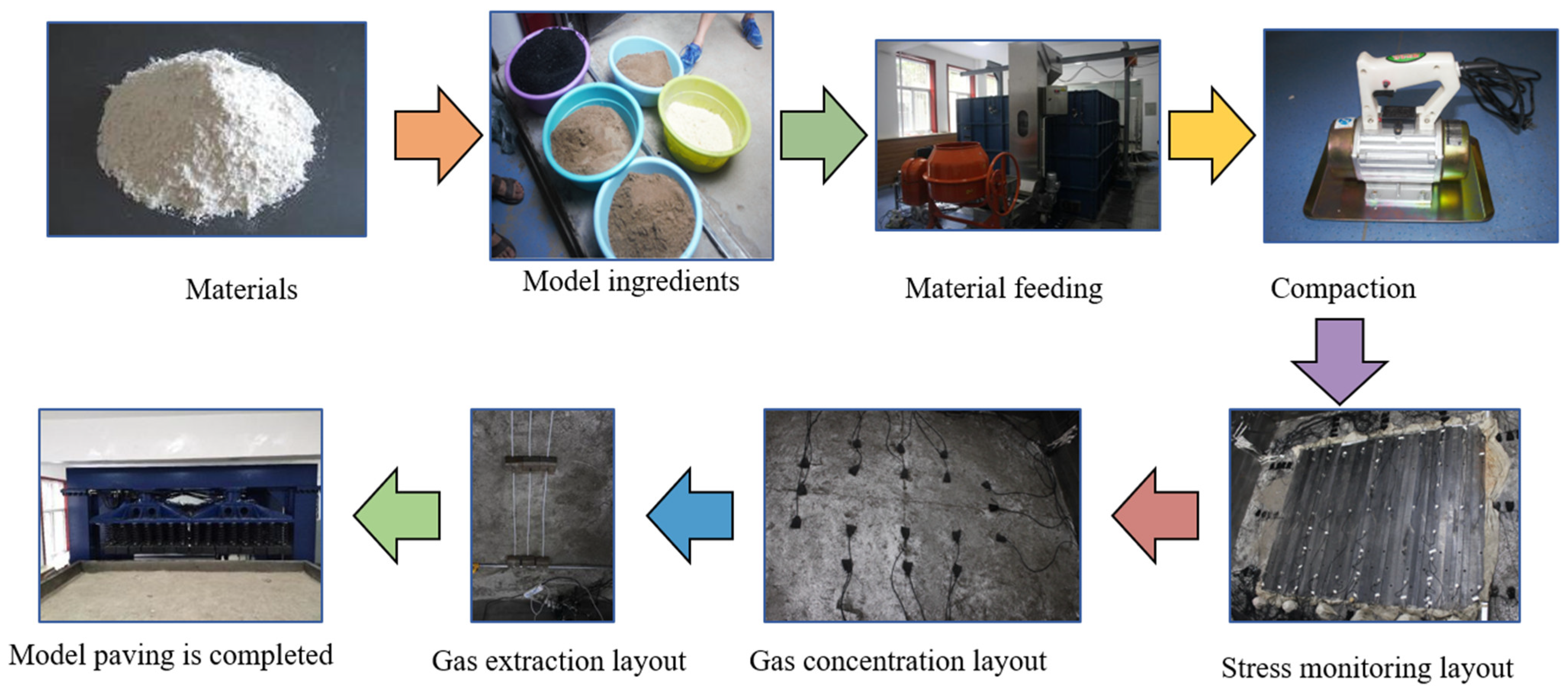
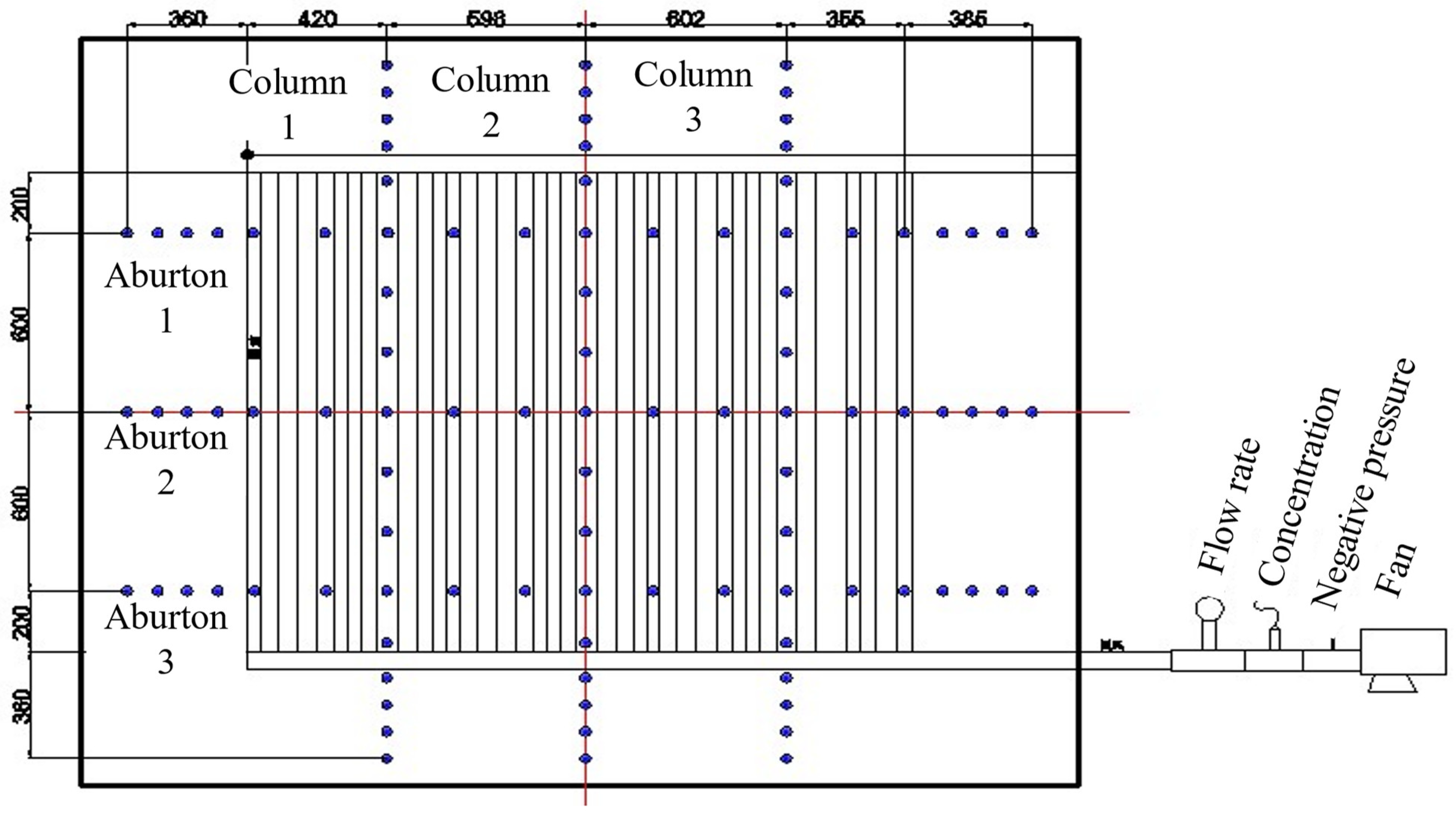
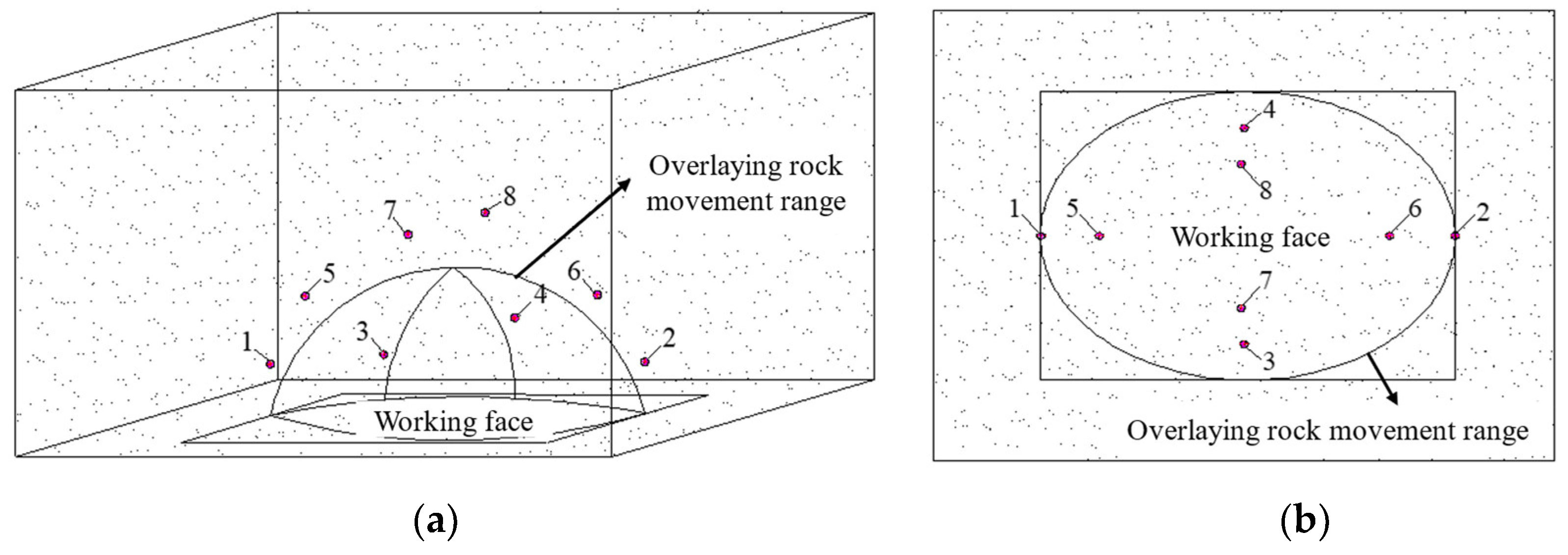
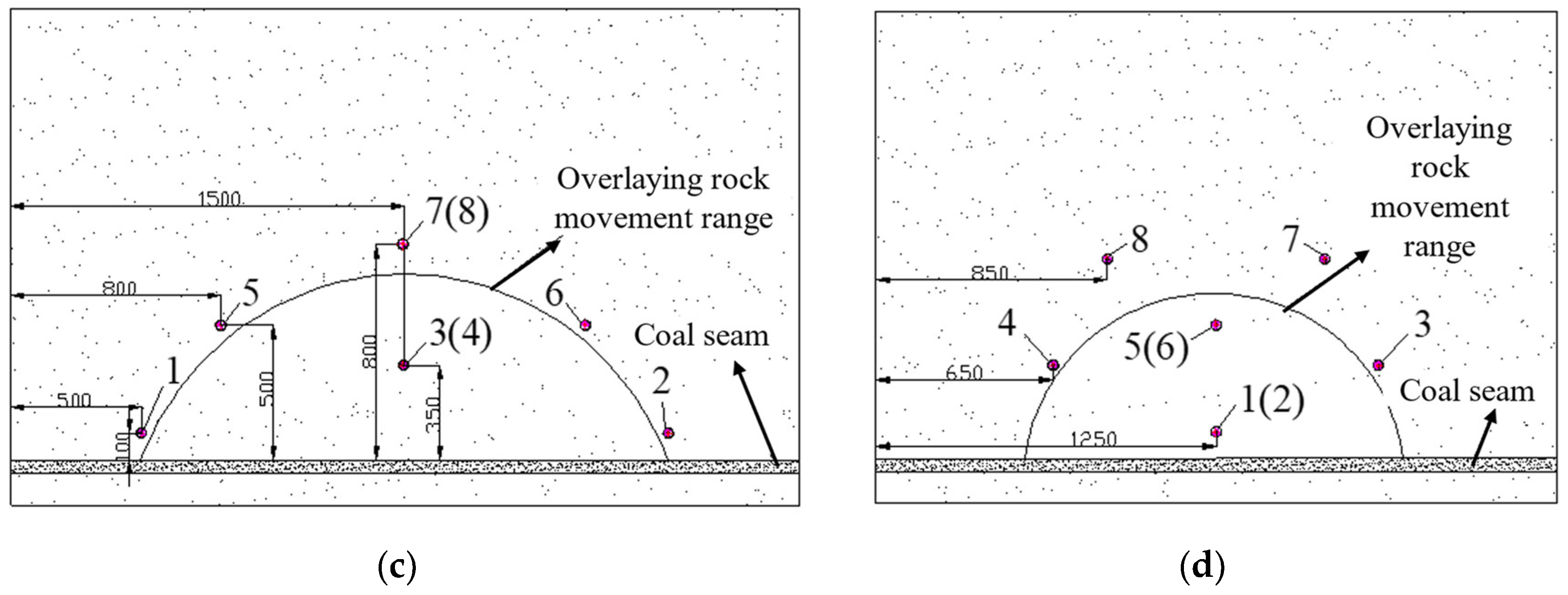



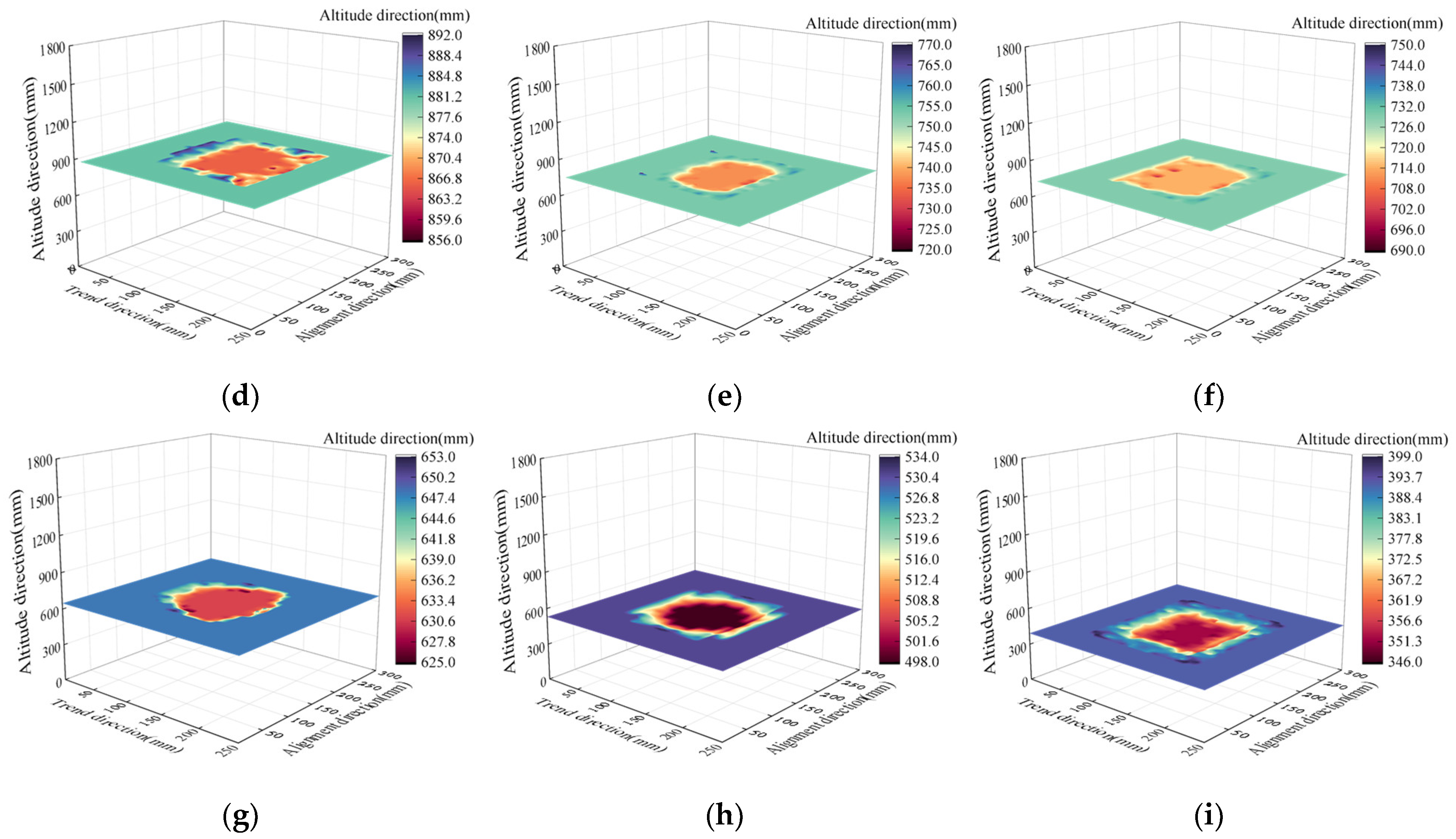
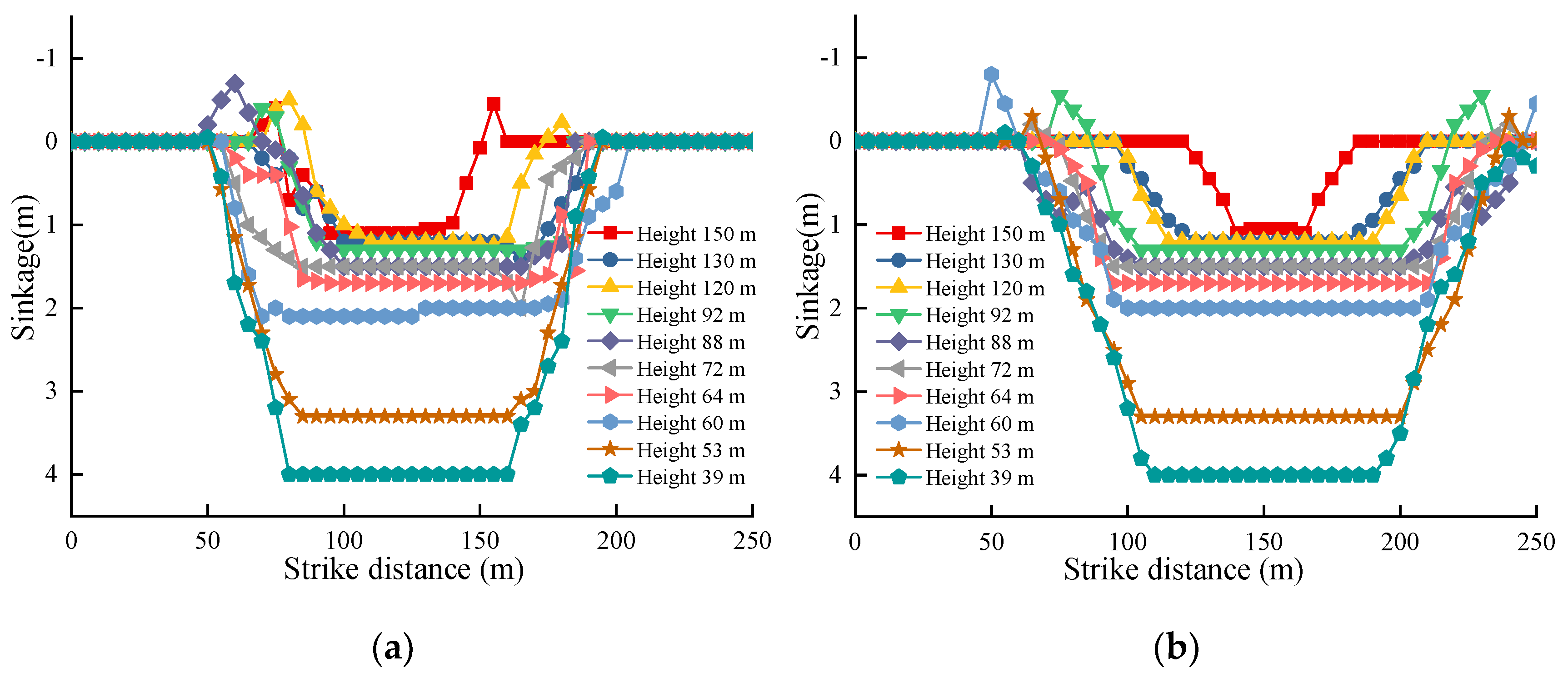
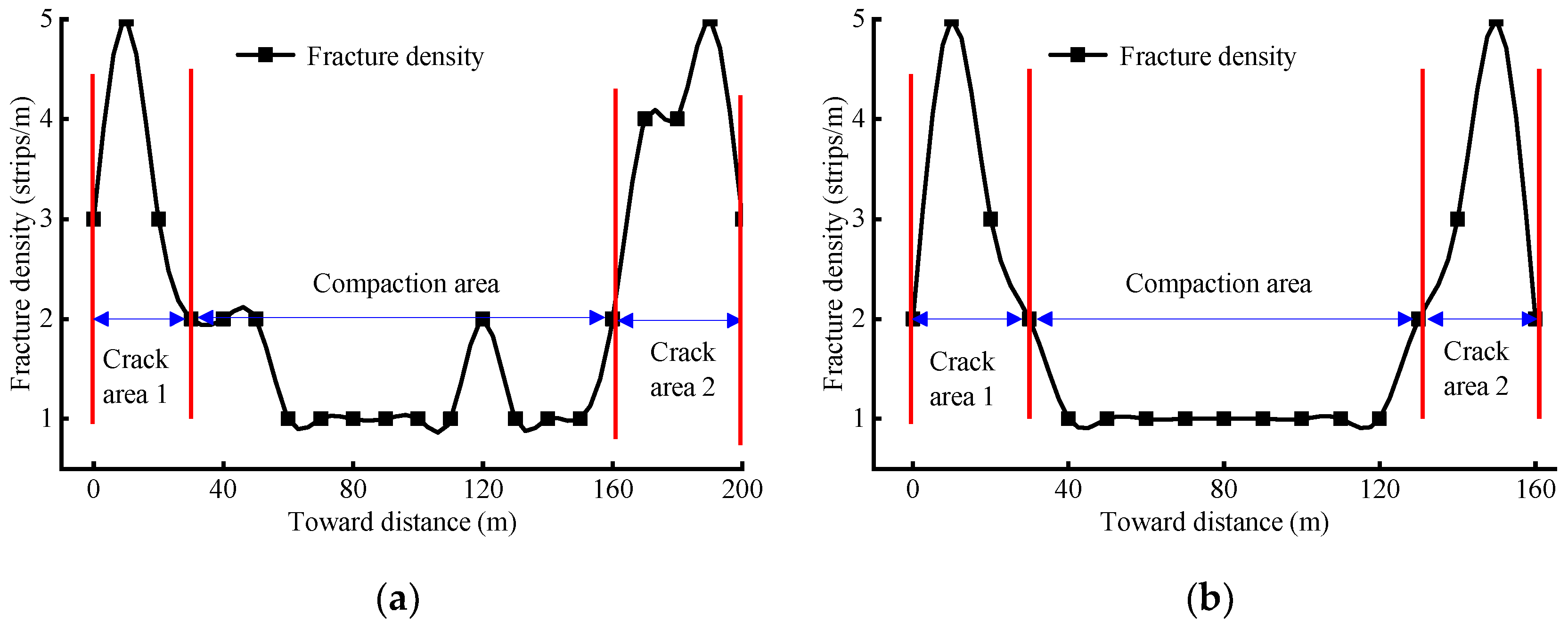
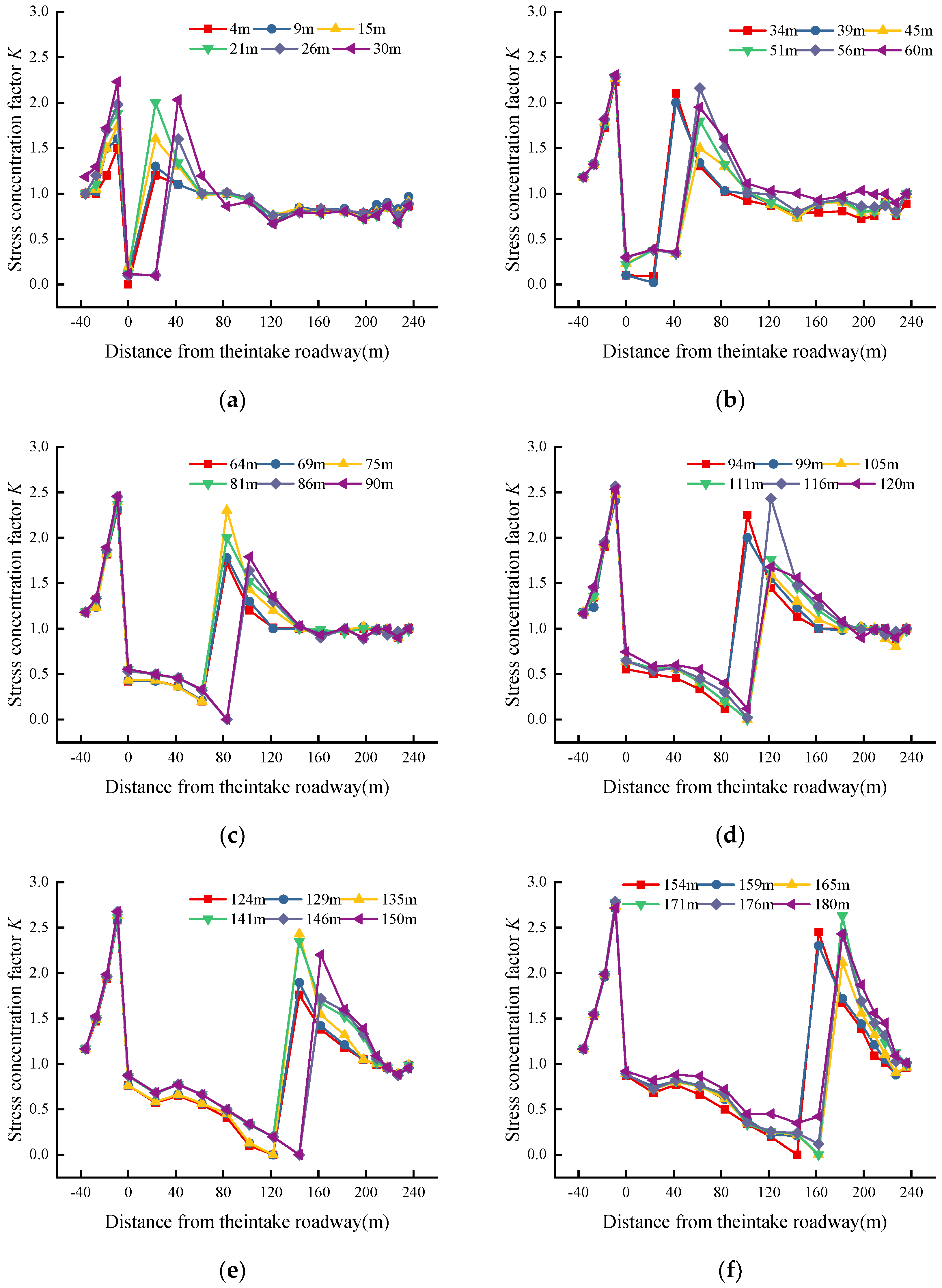

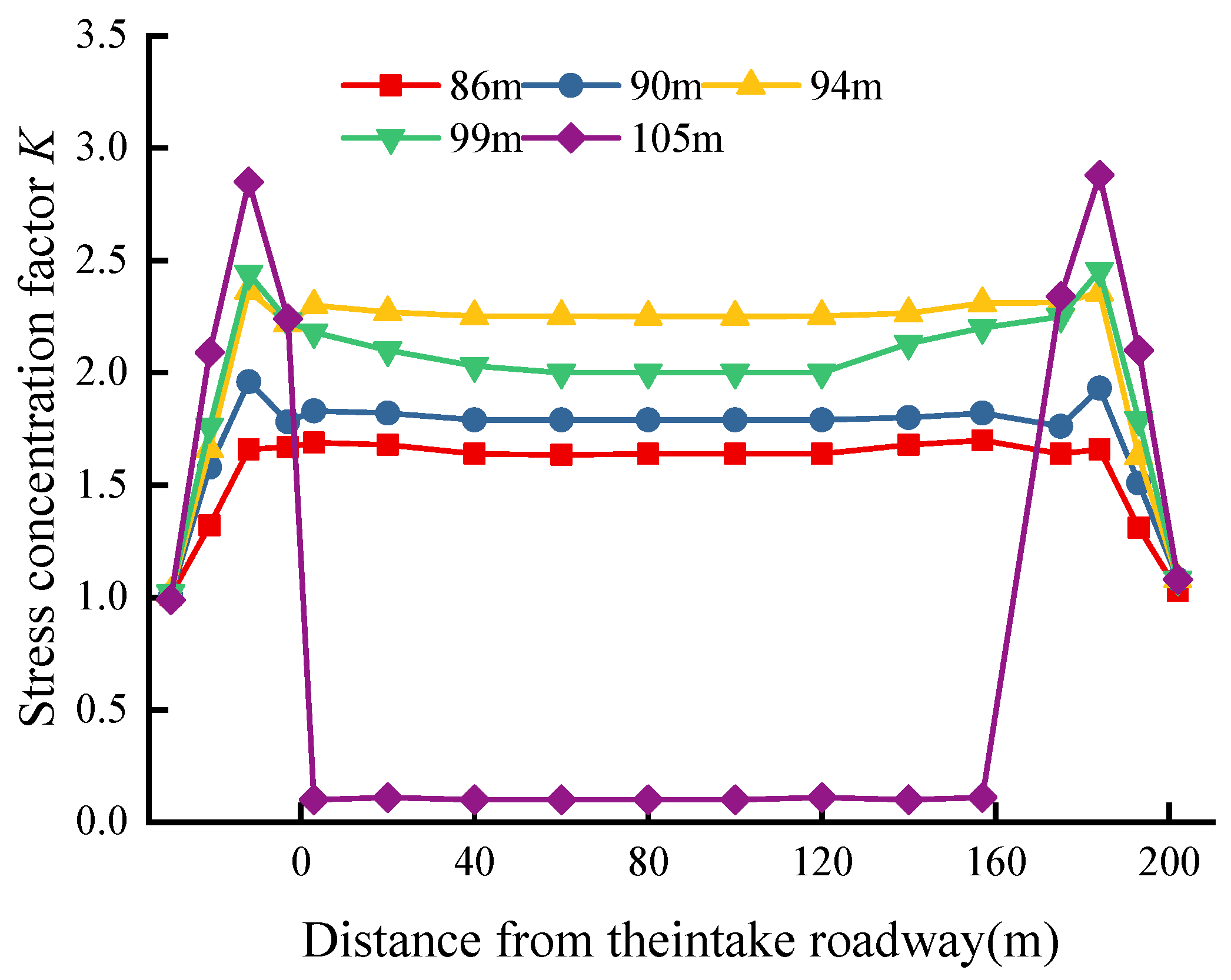
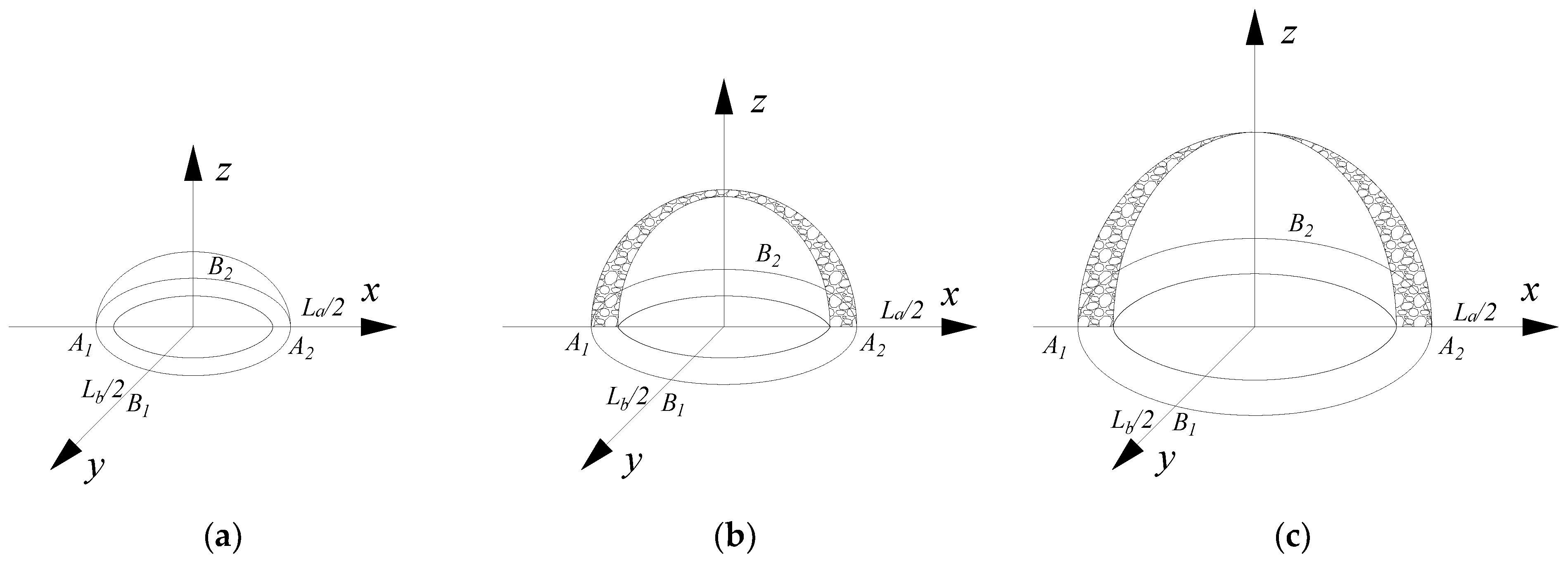
| Serial Number | Rock Stratum Name | Matching | Content (%) | |||
|---|---|---|---|---|---|---|
| Cement | Starch | Sand | Cement | Starch | ||
| 1 | Coal | 50:1 | 10 | 94.871 | 1.903 | 1.613 |
| 2 | Aluminum mudstone | 50:1 | 30 | 89.091 | 1.819 | 4.545 |
| 3 | Mudstone | 40:1 | 20 | 91.483 | 2.267 | 3.125 |
| 4 | Sandy mudstone | 20:1 | 30 | 86.592 | 4.318 | 4.545 |
| 5 | Silt sandstone | 20:1 | 50 | 81.643 | 4.071 | 7.143 |
| 6 | Fine sandstone | 10:1 | 30 | 82.652 | 8.258 | 4.545 |
| 7 | Limestone (key stratum) | 10:1 | 50 | 77.928 | 7.786 | 7.143 |
| Number | Face Advanced Distance (L/m) | Influence Range of the Advance Abutment Pressure (m) | Distance Between the Peak Stress and the Working Face (Lk/m) | Peak Stress Concentration Factor (Kmax) |
|---|---|---|---|---|
| 1 | 34 | 47 | 8 | 2.1 |
| 2 | 56 | 49 | 6 | 2.16 |
| 3 | 75 | 71 | 9 | 2.3 |
| 4 | 94 | 71 | 9 | 2.26 |
| 5 | 116 | 68 | 6 | 2.43 |
| 6 | 135 | 65 | 6 | 2.35 |
| 7 | 159 | 63 | 8 | 2.45 |
| 8 | 171 | 65 | 11 | 2.63 |
| Sensor Station | Sensor Serial Number | Distance to Air Inlet (m) | Stress Concentration Factor K | ||||
|---|---|---|---|---|---|---|---|
| Advancing 86 m | Advancing 90 m | Advancing 94 m | Advancing 99 m | Advancing 105 m | |||
| Inlet side of the coal wall | 1 | −30 | 1.01 | 1.01 | 1.019 | 1.019 | 0.99 |
| 2 | −21 | 1.32 | 1.58 | 1.66 | 1.76 | 2.09 | |
| 3 | −12 | 1.66 | 1.96 | 2.365 | 2.441 | 2.85 | |
| 4 | −3 | 1.67 | 1.782 | 2.22 | 2.23 | 2.24 | |
| Working face end | 5 | 3 | 1.69 | 1.83 | 2.3 | 2.18 | 0.1 |
| Working face middle | 9 | 80 | 1.64 | 1.79 | 2.25 | 2 | 0.1 |
| Working face end | 13 | 157 | 1.7 | 1.82 | 2.31 | 2.2 | 0.11 |
| Return air side of the coal wall | 14 | 175 | 1.64 | 1.762 | 2.312 | 2.25 | 2.34 |
| 15 | 184 | 1.66 | 1.932 | 2.357 | 2.455 | 2.88 | |
| 16 | 193 | 1.31 | 1.51 | 1.63 | 1.79 | 2.1 | |
| 17 | 202 | 1.03 | 1.08 | 1.08 | 1.08 | 1.08 | |
Disclaimer/Publisher’s Note: The statements, opinions and data contained in all publications are solely those of the individual author(s) and contributor(s) and not of MDPI and/or the editor(s). MDPI and/or the editor(s) disclaim responsibility for any injury to people or property resulting from any ideas, methods, instructions or products referred to in the content. |
© 2024 by the authors. Licensee MDPI, Basel, Switzerland. This article is an open access article distributed under the terms and conditions of the Creative Commons Attribution (CC BY) license (https://creativecommons.org/licenses/by/4.0/).
Share and Cite
Wei, Z.; Yin, Y.; Li, B.; Li, S.; Lin, H.; Xiao, P.; Ding, Y. Study on the Fracture Evolution Characteristics of Overlying Strata in a Fully Mechanized Mining Face with a Large Mining Height Based on a Three-Dimensional Large-Scale Physical Simulation Experimental System. Processes 2024, 12, 2087. https://doi.org/10.3390/pr12102087
Wei Z, Yin Y, Li B, Li S, Lin H, Xiao P, Ding Y. Study on the Fracture Evolution Characteristics of Overlying Strata in a Fully Mechanized Mining Face with a Large Mining Height Based on a Three-Dimensional Large-Scale Physical Simulation Experimental System. Processes. 2024; 12(10):2087. https://doi.org/10.3390/pr12102087
Chicago/Turabian StyleWei, Zongyong, Yucai Yin, Botao Li, Shugang Li, Haifei Lin, Peng Xiao, and Yang Ding. 2024. "Study on the Fracture Evolution Characteristics of Overlying Strata in a Fully Mechanized Mining Face with a Large Mining Height Based on a Three-Dimensional Large-Scale Physical Simulation Experimental System" Processes 12, no. 10: 2087. https://doi.org/10.3390/pr12102087





